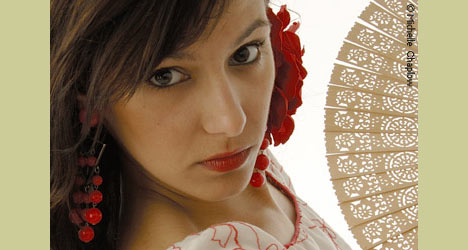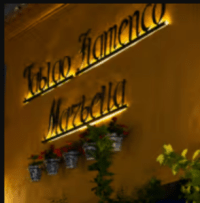
Flamenco dance Museum in Seville
For many visitors to Seville, flamenco is one of its greatest treasures. People flock to the many tablaos (flamenco bars) and flamenco shows to see a little of this Andalucían culture while visiting the city. Without a doubt, flamenco is one of the wonders of Southern Spain and after you have been to one of the many flamenco shows that are on offer in the city, you may just want to further your education on the subject. If this is the case then Seville has the answer.
Tucked away in the side streets of Alfalfa street, you will find the beautiful 18th century “Casa de Palacio” (Palace House) that is home to the “Museo del Baile Flamenco” (Museum of Flamenco Dance). This building is an institution to flamenco dance and inside you will be able to submerge yourself in this wonderful facet of Andalucían culture.
Without scripts or structured compositions, the Flamenco artists let themselves be carried away by improvisation and the passion of flamenco. Witness dancing and singing, where the a cappella voice, the guitar chords and the rhythm of the dancers will fill the stage. Dining optional. Tickets for Flamenco Show at Tablao Flamenco in Marbella.
The museum opened its doors to the public in April 2006 and was masterminded by the renowned flamenco dancer, Cristina Hoyos, who was born, and grew up in the very same streets where the museum now stands.
Cristina is one of the most important and respected dancers of late and she has worked with many of the legends of flamenco dance, many of who are honoured in her museum. Different areas of the museum are dedicated to Cristina’s teachers and associates who include Antonio Gades, Enrique el Coto and Pilar Lopez.
Cristina, who is also the director of the Ballet Flamenco de Andalucía (Andalucian Flamenco Ballet), has said that the museum had been a dream for many years and she was eventually able to turn it into reality when it was finally opened two years ago. She has also said that the Museo del Baile Flamenco was her way of giving a little back to an art that has given so much to her.
The Patio
The flamenco dance museum is situated in Calle Manuel Rojas Marcos 3, in the heart of the historic old part of the city, and is just a few minutes walk from the cathedral. This old four-story palace, which has kept much of its 18th century appeal, is where the deepest roots of flamenco and the latest state of the art technology come together to start you on your journey into the magical world of flamenco dance.
When you visit this unique museum you will be absorbed into one of the country’s most mystical phenomena, a culture that up until now has been little understood by the outside world. This museum is a meeting place for explaining the mysteries of the flamenco dance, and after your visit you will most likely wish to buy a book on the subject or even book yourself a dance lesson, in hopes of educating yourself a little more in the art of flamenco.
The Chairs

The Chairs
At the basement level you will begin to feel the atmosphere of this building. Arched brick passageways will lead you into the old cellar, where workshops and flamenco recitals are regularly held. A small patio complete with a trickling fountain will tempt you to sit and take in the ambience before you start on your tour of the museum.
The ground floor houses the teaching area where dance and guitar classes take place from beginners to the most advanced courses. They also have lessons for flamenco singing as well as rhythm classes, plus lectures on the history of flamenco where you will learn about some of the great personalities of this art.
There is also another small patio on this level complete with a small stage where flamenco shows are held in the evenings. This area also houses a permanent exhibition of charcoal drawings by Miguel Alcalá and paintings by the German artist Sophie Mühlenburg, which capture different aspects and emotions of flamenco dance.
The first floor is where you really begin to understand what the museum is all about, the old style dress room is where costumes and memorabilia from the classic era of flamenco can be viewed, along with some of the treasures from Cristina Hoyos’ screen performances.
In 1978 Cristina appeared alongside Antonio Gades in the Carlos Saura screen adaptation of Bodas de Sangre (Blood Wedding) and many of the film’s costumes and props, including the knife from the famous fight scene, as well as the artistes dressing table, can be seen here. Hats, shawls, castanets, fans and old posters of flamenco shows are all on display to remind you of flamenco’s rich and elegant past.
This institution is a mixture of old style museum and 21st century technology, as the screen room will prove. In this extremely high-tech area, you are taken on a journey through the evolution of this most Spanish dance, from its earliest days when the gypsies danced for pleasure in the streets and on their patios, through the Café Cantante period, to the present day theatre shows.
Large screens display how the concept of the dance has changed from the earliest styles right up until modern trends performed by today’s artistes like Antonio el Pipa and El Lebri. Everything is explained clearly and all you have to do is select your language of choice (Chinese, Japanese, German, French, English, and of course Castilian Spanish) and you will be instructed on the ancient styles of dance, which have influenced flamenco as we know it today.
From here you will be led into the tablao room, where from you will be entertained in the atmosphere that re-creates the tablao or flamenco club. Large screens relay images of a dance show similar to what you would experience at one of Andalucuia’s many flamenco clubs and bars, only here you will be entertained by Cristina Hoyos and her own dance company.
One thing you will be subjected to throughout your visit will be the strains of Indian and Arabic music which are mixed with the sound of clicking castanets, stomping feet and the mellow strings of the flamenco guitar, most of which come from the academy on the first floor

Museo flamenco, Seville
There is an interesting sculpture that hangs from the top floor and is visible from all parts of the museum thanks to the open style of the building. This monument to flamenco is a collection of the high backed Andalucían chairs so commonly used by those who accompany the guitarist. They are suspended along with two lemon trees, symbols of Andalucía and the art of flamenco.
Lining the walls around this area are dozens of black and white photographs of some of the most famous people connected to the world of flamenco. Paco de Lucía, Matilda Coral, Carmen Amaya, La Chunga and Antonio el Bailarín, who was considered to be the greatest flamenco dancer in the world, are all displayed on this wall of fame. There are also some very interesting photographs of Antonio Gades performing during the 1960s and one photo of La Paquera de Jerez performing at the extremely popular tablao Torres Bermejas, in Madrid. This tablao was a starting point for many of today’s top artistes and just about everybody passed through its doors during the sixties and seventies.
Dressing Room
The second floor takes you up to the exhibition of works by Vicente Escudero, considered one of the most important characters in the history of modern flamenco dance. This flamenco dancer was also an avid artist and during his long artistic life he produced dozens of flamenco sketches and colourful paintings that reflect his attitude towards flamenco dance. There are also many photographs and newspaper articles about Escudero, who will be remembered as one of the most controversial dancers of the twentieth century.
Cristina Hoyos says that she intends to organize special tributes to dancers who have played an important role in the evolution of flamenco dance. She believes that not enough has been done for artistes like Antonio Gades who died in 2004 or Pilar López, who is a glorious 96 years of age, and whose career has been a milestone in the history of Spanish dance.
So this is it, the first flamenco dance museum in the world. And if you still want more information or even a souvenir to take home, then don’t forget the museum shop, which is located on the ground floor next to the reception area. This large exclusive shop sells everything from CD’s and DVD’s, to dance shoes and guitars, posters, magazines and also a range of flamenco books in numerous languages where you can learn even more about this most wonderful art.
The museum shop also sells an exclusive range of custom made jewellery and each piece is hand made and unique to the museum. You will find all of the staff at the museum extremely polite and helpful.
So if it’s flamenco dance that you are interested in and would like to know a little more, or maybe you want to go the full nine yards and book yourself a dance course, then this is the place to head.
Permanent Exhibition
For information on any of the classes or courses available at the museum contact Juan Peredes, the class manager, on 954 34 03 11.
The museum is open seven days a week from 9am until 6pm Nov-March and until 7pm April-Oct, including holidays.
Entrance – Adults: 10 Euros – Groups: 8 Euros per person – Children: 6 Euros
